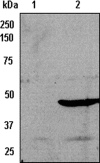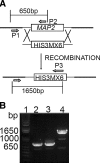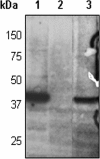System for expression of microsporidian methionine amino peptidase type 2 (MetAP2) in the yeast Saccharomyces cerevisiae
- PMID: 16917013
- PMCID: PMC1610073
- DOI: 10.1128/AAC.00726-06
System for expression of microsporidian methionine amino peptidase type 2 (MetAP2) in the yeast Saccharomyces cerevisiae
Abstract
Microsporidia are parasitic protists of all classes of vertebrates and most invertebrates. They recently emerged as important infections in various immunosuppressed and immunocompetent patient populations. They are also important veterinary and agricultural pathogens. Current therapies for microsporidiosis include benzimidazoles, which bind tubulin-inhibiting microtubule assembly, and fumagillin and its derivatives, which bind and inhibit methionine amino peptidase type 2 (MetAP2). Benzimidazoles are not active against Enterocytozoon bieneusi, the most common cause of human microsporidiosis. Fumagillin is active against most microsporidia, including E. bieneusi, but thrombocytopenia has been a problem in clinical trials. There is a pressing need for more-specific microsporidian MetAP2 inhibitors. To expedite and facilitate the discovery of safe and effective MetAP2 inhibitors, we have engineered Saccharomyces cerevisiae to be dependent on Encephalitozoon cuniculi MetAP2 (EcMetAP2) for its growth, where EcMetAP2 is harbored on an episomal uracil-selectable tetracycline-regulated plasmid. We have also constructed a leucine-selectable tetracycline-regulated expression plasmid into which any MetAP2 gene can be cloned. By utilizing a 5-fluoroorotic acid-mediated plasmid shuffle in the EcMetAP2 yeast strain, a yeast strain can be generated whose growth is dependent on MetAP2 from any organism. The level of heterologous MetAP2 gene expression can be controlled by the addition of tetracycline to the growth medium. These yeast strains should permit high-throughput screening for the identification of new inhibitors with high specificity and activity toward microsporidian MetAP2.
Figures






Similar articles
-
Methionine aminopeptidases: Potential therapeutic target for microsporidia and other microbes.J Eukaryot Microbiol. 2024 Sep-Oct;71(5):e13036. doi: 10.1111/jeu.13036. Epub 2024 Jul 22. J Eukaryot Microbiol. 2024. PMID: 39036929 Free PMC article. Review.
-
Structure of a microsporidian methionine aminopeptidase type 2 complexed with fumagillin and TNP-470.Mol Biochem Parasitol. 2009 Dec;168(2):158-67. doi: 10.1016/j.molbiopara.2009.07.008. Epub 2009 Aug 4. Mol Biochem Parasitol. 2009. PMID: 19660503 Free PMC article.
-
Investigations into microsporidian methionine aminopeptidase type 2: a therapeutic target for microsporidiosis.Folia Parasitol (Praha). 2005 May;52(1-2):182-92. doi: 10.14411/fp.2005.023. Folia Parasitol (Praha). 2005. PMID: 16004378 Free PMC article.
-
Evidence of a dominant negative mutant of yeast methionine aminopeptidase type 2 in Saccharomyces cerevisiae.J Cell Biochem. 2005 Mar 1;94(4):656-68. doi: 10.1002/jcb.20285. J Cell Biochem. 2005. PMID: 15547949
-
Therapeutic targets for the treatment of microsporidiosis in humans.Expert Opin Ther Targets. 2018 Nov;22(11):903-915. doi: 10.1080/14728222.2018.1538360. Epub 2018 Nov 1. Expert Opin Ther Targets. 2018. PMID: 30336698 Free PMC article. Review.
Cited by
-
Long-Term Prophylactic Antibiotic Treatment: Effects on Survival, Immunocompetence and Reproduction Success of Parasemia plantaginis (Lepidoptera: Erebidae).J Insect Sci. 2016 Jun 7;16(1):46. doi: 10.1093/jisesa/iew035. Print 2016. J Insect Sci. 2016. PMID: 27271967 Free PMC article.
-
Scientific Advances in Controlling Nosema ceranae (Microsporidia) Infections in Honey Bees (Apis mellifera).Front Vet Sci. 2019 Mar 15;6:79. doi: 10.3389/fvets.2019.00079. eCollection 2019. Front Vet Sci. 2019. PMID: 30931319 Free PMC article. Review.
-
Methionine aminopeptidases: Potential therapeutic target for microsporidia and other microbes.J Eukaryot Microbiol. 2024 Sep-Oct;71(5):e13036. doi: 10.1111/jeu.13036. Epub 2024 Jul 22. J Eukaryot Microbiol. 2024. PMID: 39036929 Free PMC article. Review.
-
Unraveling the Gene Regulatory Networks of the Global Regulators VeA and LaeA in Aspergillus nidulans.Microbiol Spectr. 2023 Mar 15;11(2):e0016623. doi: 10.1128/spectrum.00166-23. Online ahead of print. Microbiol Spectr. 2023. PMID: 36920196 Free PMC article.
-
Parasitic diarrheal disease: drug development and targets.Front Microbiol. 2015 Oct 27;6:1183. doi: 10.3389/fmicb.2015.01183. eCollection 2015. Front Microbiol. 2015. PMID: 26617574 Free PMC article. Review.
References
-
- Cali, A., P. M. Takvorian, S. Lewin, M. Rendel, C. S. Sian, M. Wittner, H. B. Tanowitz, E. Keohane, and L. M. Weiss. 1998. Brachiola vesicularum, n.g., n.sp., a new microsporidium associated with AIDS and myositis. J. Eukaryot. Microbiol. 45:240-251. - PubMed
-
- Corey, E. J., A. Guzman-Perez, and M. C. Noe. 1994. Short enantioselective synthesis of (−)-ovalicin, a potent inhibitor of angiogenesis, using substrate-enhanced catalytic asymmetric dihydroxylation. J. Am. Chem. Soc. 116:12109-12110.
Publication types
MeSH terms
Substances
Grants and funding
LinkOut - more resources
Full Text Sources
Molecular Biology Databases

